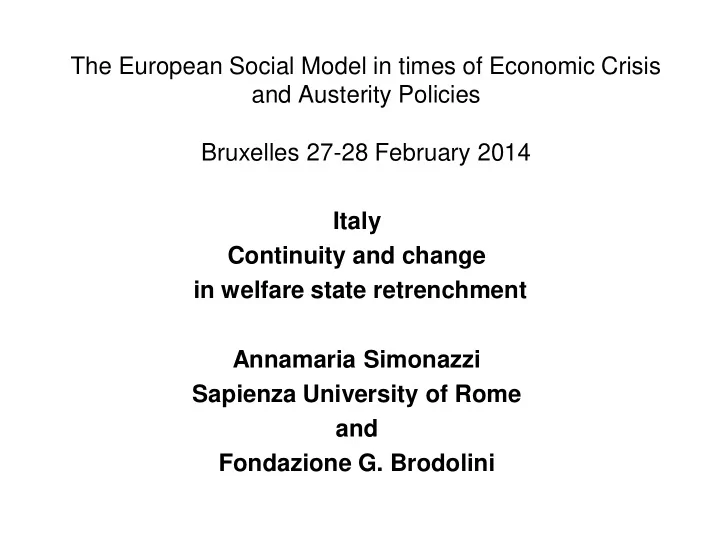

The European Social Model in times of Economic Crisis and Austerity Policies Bruxelles 27-28 February 2014 Italy Continuity and change in welfare state retrenchment Annamaria Simonazzi Sapienza University of Rome and Fondazione G. Brodolini
Before the crisis • Slow growth • Social protection: lack of universal coverage; highly segmented; relying heavily on the family • Labour market reforms: flexibility at the margin increased segmentation and precariousness for new entrants • Public debt: perverse redistribution Public debt: constantly above 100% of GDP since the ’90 Service of the debt: 1990-1997 Constantly above 10% of GDP 2000s Hovering around 5% of GDP
Public and Primary deficits
The legacy of the debt: Fiscal consolidation • No stimulus measures: 2008-2010 fiscal stimulus % of GDP Italy: 0.3% main advanced economies: 3.4% (IMF) • Policies lacking coherence and design – dictated by the need to reassure the «markets» (and the European authorities); – designed without a general framework; – and with scant consideration for long-term consequences (TINA) • Cuts in social spending: - block on turnover: public employment: -8% since 2006, 70% of whom in education (BI 2013) - Cuts in social funds and financial transfers to local authorities • Increase in direct and indirect taxation 2013: tax/GDP: 31.6% overall fiscal burden/GDP: 45.4% • Families: welfare of (first and) last resort
Macroeconomic consequences of fiscal austerity • The economic (and financial) crisis combined with fiscal austerity deepened the crisis 2008-2013: GDP declined by 8% ; Industrial production: 26%; Investment: 28% • Employment: no universal relief measures - Cassa integrazione - for workers on «typical» contracts: half a million workers) - labour shedding (temporary contracts) - involuntary part-time (female employment) • Fall in disposable income (+ uncertainty) Private consumption: - 5.1% over the period, of which - 4.3% in 2012 • Erosion of savings and decline in the saving rate, concentrated on the lowest quintile, households of young people and tenants • Households’ wealth has diminished by 5.7% (1/3 of GDP) since 2008 (BI estimates) : (in 2010-11 the wealth to income ratio was 8.01 for Italian households and 4.48 for German ones (HFCS). • And overall inequality in wealth distribution has increased: the richest 10% owns about 50% of total wealth.
A steep increase in poverty and vulnerability • Missing: policies to counter poverty and social exclusion • The income distribution has become more fragmented and unequal between and within social classes, within wage earners (working poor and working rich), and inside families. • The share of severely deprived households (defined has families having 4 or more out of 9 indicators of severe material deprivation) – 6.9% in 2010; 11.2% in 2011; 14.3% in 2012. (more than 7 points in 3 years) • Limited role of social transfers to reduce relative poverty: 19.7% compared with 35.2% for the EU27 (not because of scant resources but lack of universality of social protection and inefficient use of resources: Baldini et al.2013).
Families’ impoverishment: reinforcing inequality, reducing social cohesion and growth • Families are caught between increasing demands (cuts in welfare, decrease in income, increase in unemployment) and decreased redistributive capabilities decumulation of previous savings • Increasing reliance on families as insurers against social risks tends to reinforce social inequality, because of the strongly unequal distribution of income and savings (social mobility) • Fragmentation of society poses serious problems to policy since it affects social cohesion and political support to redistribution via taxation • Macroeconomic implications: national solvency (households’ wealth as collateral for public debt), reduction in the quantity and quality of consumption affects demand and growth
Long-term, supply-side consequences of fiscal austerity and erosion of WS The welfare state as a “productive factor” and long -term unsustainability of the current policies • Cuts in social services and reconciliation policies – employment and female labour supply – fertility rate and demographic sustainability (pension system, LTC) • (Youth) long-term unemployment and fragmented careers – Decay of skills – Delay in family formation – Fall in income and pensions rights • Cuts in current expenditure: reduces social investment (e.g. education and human capital) affecting up-grading of the economic system • Drop in income, consumption, investment and public spending: domestic demand in support of firms’ survival erosion of productive basis • Unless policies are reversed: quiet collapse
Recommend
More recommend